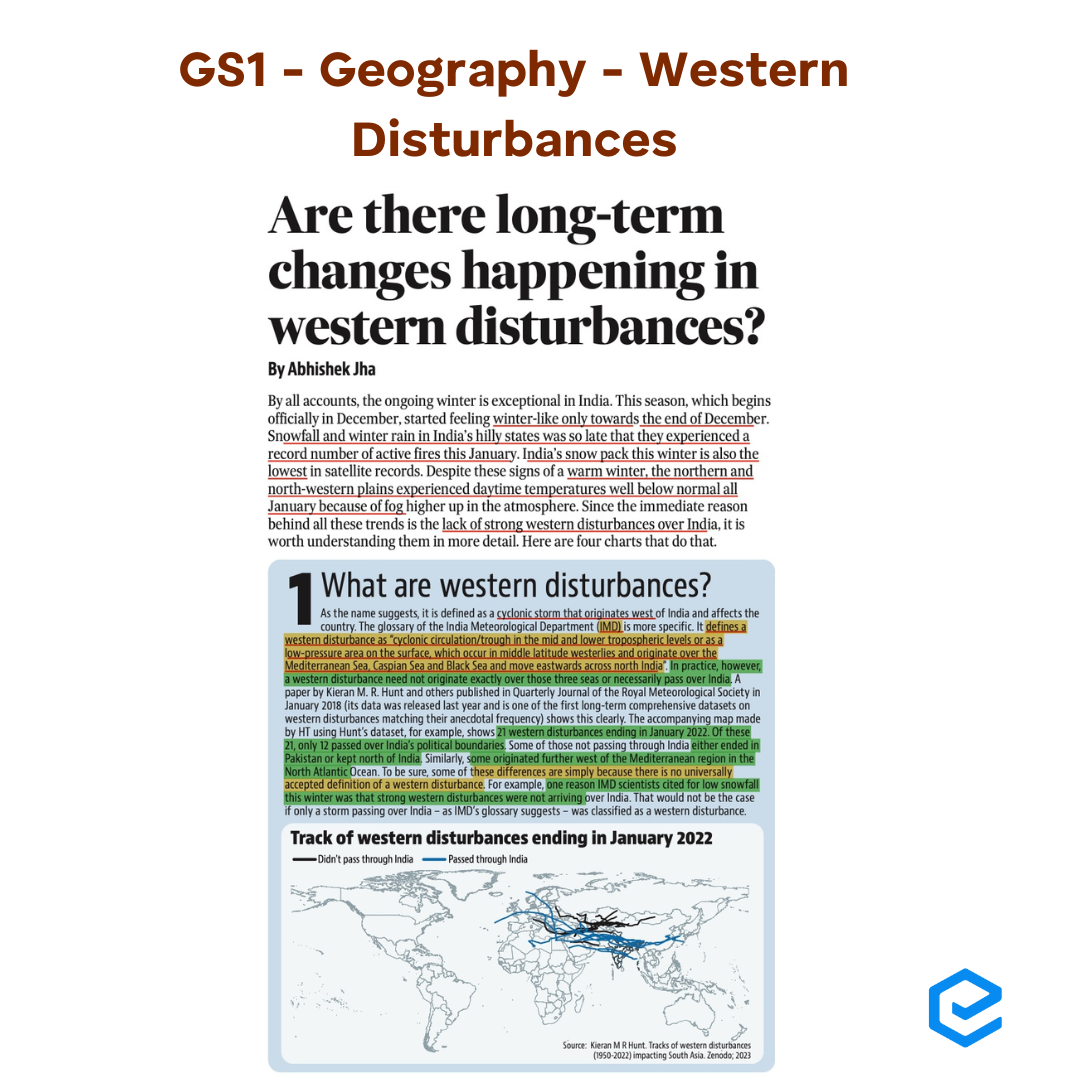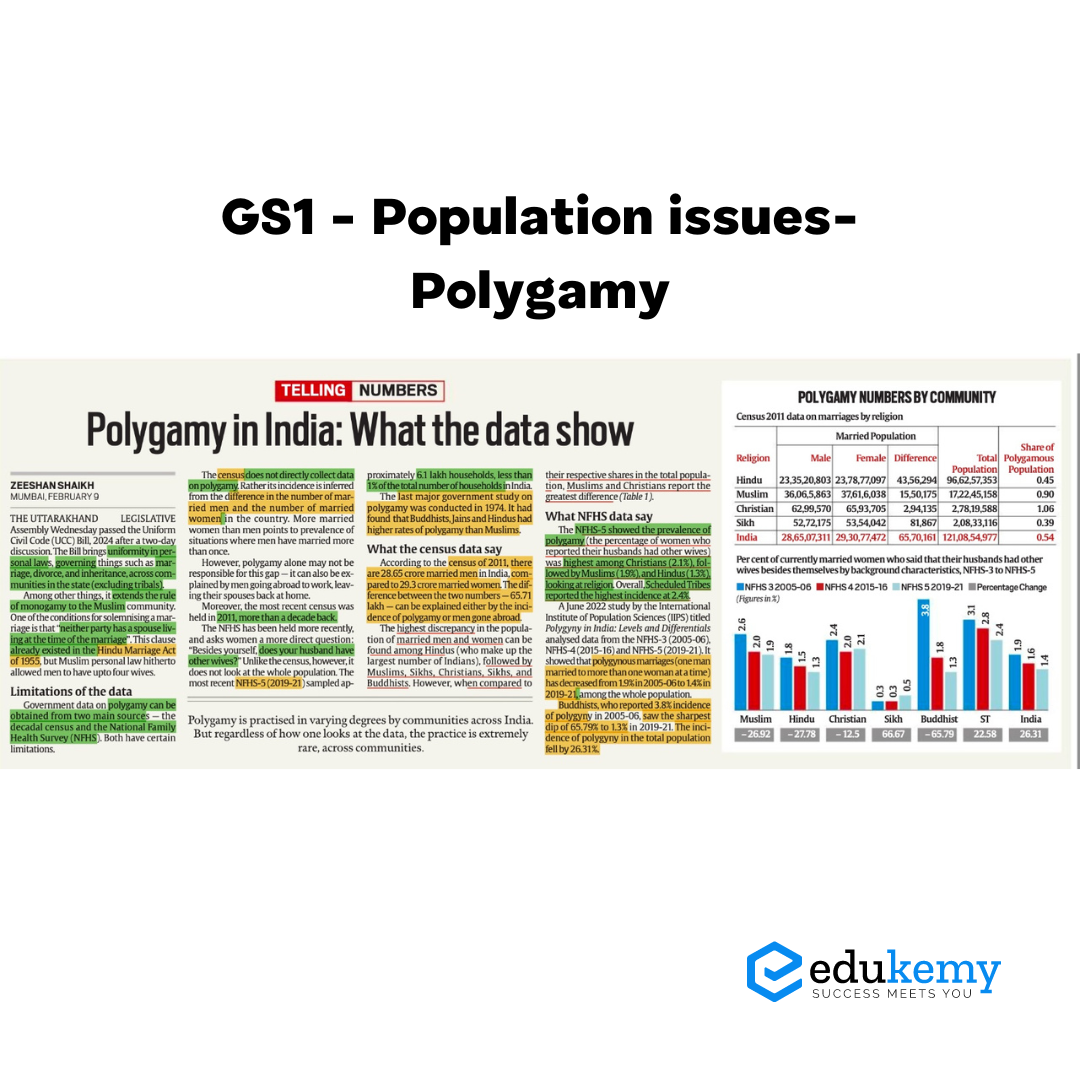Thursday, 15th February 2024
Rights of Forest-Dwellers in India
In News: Forest-dwellers in the vicinity expressed concerns following the recent notification of the Thanthai Periyar Sanctuary in the Erode district of Tamil Nadu earlier this month.
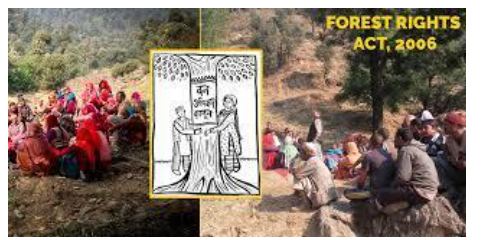
Forest Rights Act (FRA), 2006: Empowering Tribal Communities
Overview
- The Forest Rights Act (FRA), 2006 acknowledges the rights of forest-dwelling tribal communities and traditional forest dwellers to forest resources essential for livelihood, habitation, and socio-cultural needs.
Objectives of the Forest Rights Act
- Undoing Historical Injustice
- The FRA aims to rectify historical injustices faced by forest-dwelling communities.
- Ensuring Land Tenure and Livelihood Security
- To guarantee land tenure, livelihood, and food security for forest-dwelling Scheduled Tribes and traditional forest dwellers.
- Strengthening Conservation Regime
- To enhance forest conservation by entrusting responsibilities and authority to Forest Rights holders for sustainable use, biodiversity conservation, and ecological balance.
Rights Granted Under the Act
- Land Rights
- Forest dwellers have the right to own cultivated land, limited to a maximum of 4 hectares per family.
- Ownership is granted only for actively cultivated land, with restrictions on sale or transfer, permitted only through inheritance.
- Use Rights
- Rights extend to extracting Minor Forest Produce, grazing areas, pastoralist routes, etc.
- Excludes ownership of timber.
- Right to Protect and Conserve
- Communities gain the right to protect and manage forests, crucial in combating threats from forest mafias, industries, and land grabbers.
Eligibility and Recognition of Rights
- Claimants
- Members of Scheduled Tribes residing in and depending on forests for livelihood.
- Any member or community residing in forests for at least three generations (75 years) before December 13, 2005.
- Recognition Process (Section 6)
- Gram Sabha recommends rights, including land cultivation and forest produce collection.
- Recommendations undergo scrutiny by screening committees at the Taluka and District levels.
- District Level Committee, comprising three government officers and three elected individuals, makes the final decision.
Gram Sabha: A Key Component
- Definition and Role
- Comprises all persons on the electoral rolls for the village-level Panchayat, as defined in Article 243(b) of the Constitution.
Rights in Thanthai Periyar Sanctuary
- Grazing Restrictions
- Recent notifications impose restrictions on cattle-grazing in the Thanthai Periyar Sanctuary.
- Impact on Bargur Cattle
- Traditional grazing grounds of Bargur cattle, native to the Bargur forest hills, may be affected.
- Legal Context
- In March 2022, the Madras High Court revised a ban on cattle grazing, limiting it to national parks, sanctuaries, and tiger reserves, unique to Tamil Nadu.
- Contradiction with FRA
- Despite the FRA recognizing grazing rights of nomadic or pastoralist communities, the ban in Tamil Nadu remains in effect.
Source: TH
UN World Restoration Flagships
In News: Seven initiatives across Africa, Latin America, the Mediterranean, and Southeast Asia have been acknowledged by the United Nations as Flagships for World Restoration.
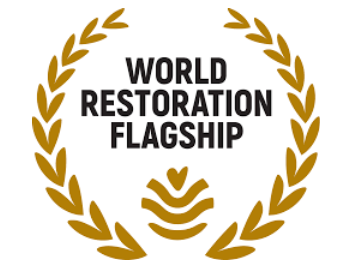
UN-Recognized World Restoration Flagships: Leading Initiatives in Ecosystem Restoration
- The Restoring Mediterranean Forests Initiative
- Participating Countries
- Lebanon, Morocco, Tunisia, and Türkiye.
- Achievements
- Innovative approach protecting and restoring natural habitats.
- Restoration of 2 million hectares since 2017, with a target of over 8 million by 2030.
- Participating Countries
- The Living Indus Initiative
- Launch and Partners
- Launched after 2022 climate change-induced floods at the 27th Conference of Parties.
- Involves Australia, Bangladesh, Bolivia, Brazil, Canada, Ecuador, India, New Zealand, Peru, and Sri Lanka.
- Goals
- Restoration of 25 million hectares in the Indus river basin by 2030.
- Designates the Indus River as a living entity with rights.
- Launch and Partners
- Acción Andina Social Movement
- Lead Organization
- Led by the non-profit Andean Ecosystems Association (ECOAN).
- Objectives
- Protection and restoration of one million hectares of Andean forests.
- Securing land titles for local communities and safeguarding forests from mining and timber exploitation.
- Lead Organization
- Sri Lanka Mangrove Regeneration Initiative
- Leadership and Approach
- Science-driven program co-led by local communities.
- Progress
- 500 hectares of mangroves restored since 2015.
- Aims to restore 10,000 hectares of mangroves by 2030.
- Leadership and Approach
- Terai Arc Landscape(TAL) Initiative
- Geographical Focus
- Encompasses critical corridors of the TAL across India and Nepal.
- Targets
- Restoration of 350,000 hectares of forests by 2030.
- Positive impact on livelihoods and increased tiger population in the shared landscape.
- Geographical Focus
- Regreening Africa’s Agriculture
- Benefits
- Increases carbon storage, enhances crop and grass yields, and promotes soil resilience.
- Prevents floods and provides fixed nitrogen as a natural fertilizer.
- Benefits
- Growing Forests in Africa's Drylands Initiative
- Expansion and Involvement
- Aims to expand restoration from 41,000 to 229,000 hectares by 2030.
- Involves African farmers, planting millions of trees annually, creating jobs and supporting sustainable development.
- Expansion and Involvement
Understanding UN World Restoration Flagships
- About
- Part of the UN Decade on Ecosystem Restoration led by UNEP and FAO.
- Recognized through the World Restoration Flagship Award.
- Significance
- Global recognition and celebration of successful restoration initiatives.
- Eligibility for technical and financial assistance, attracting global attention and investments.
- Featured in the UN Decade’s publications, campaigns, and the Secretary-General’s Report to the General Assembly.
|
UPSC Previous Year Questions Prelims (2012) Q. Which of the following can be threats to the biodiversity of a geographical area?
Select the correct answer using the codes given below: (a) 1, 2 and 3 only Ans: (a) Prelims (2011) Q2. Biodiversity forms the basis for human existence in the following ways:
Select the correct answer using the codes given below: (a) 1, 2 and 3 only Ans: (d) Mains (2018) Q. How does biodiversity vary in India? How is the Biological Diversity Act,2002 helpful in the conservation of flora and fauna? |
Source: DTE
Potential of India’s AVGC-XR Sector
In News: The AVGC-XR sector in India is poised for a significant leap forward in the next five to six years.
Outlook of India’s AVGC-XR Sector: A Comprehensive Analysis
Industry Landscape
- Ecosystem Strength
- India hosts over 4,000 studios, concentrated in key hubs like Mumbai, Bengaluru, Pune, Hyderabad, and Chennai.
- Expansion noted in smaller towns, showcasing the sector's widespread growth.
- Cultural Heritage and Artistic Prowess
- India's diverse art forms and cultural richness serve as the foundation for its visual arts excellence.
- Recognizing significant potential for value creation and employment generation.
Employment
- Diverse Job Positions
- Direct job opportunities for content developers, animators, pre- and post-production artists, pre-visualization artists, and compositors.
- High-paced growth, with specific AVGC-XR segments expanding at an annual rate of 30-35%.
Projected Growth
- Ambitious Targets
- AVGC-XR sector, currently employing 2.6 lakh individuals, aims to create 23 lakh direct jobs by 2032.
- Revenue projection to exceed USD 26 billion by 2030, up from the current USD 3 billion.
- Aspires for India to capture 5% (USD 40 billion) of the global market share by 2025.
- Global Market Potential
- Current contribution to global AVGC-XR sector stands at 0.5%.
- Potential to increase to 5%, generating over 1,60,000 new jobs annually.
Challenges Associated with AVGC Sector
- Data Deficiency
- Lack of authentic data hinders decision-making for entities in the AVGC sector.
- Skill Gap
- Workforce needs specialized skills, but a significant gap exists in education and employment sectors.
- Infrastructure Limitations
- Inadequate training infrastructure impacts the quality of training and human resources.
- Research and Development Gap
- Urgent need for research-related narratives to enhance focus on the AVGC-XR sector.
- Absence of Academic Apex
- Unlike other sectors, no apex institute in India dedicated to the AVGC domain.
- Funding Challenges
- Lack of dedicated funds impedes sector growth in India.
- IP Deficiency
- Limited globally-popular Indian intellectual property in the AVGC sector.
Government Initiatives
- Educational Integration
- NEP 2020 integrates creative arts, design, and sports into school curriculums, fostering talent in AVGC-XR.
- Introduction of AVGC-XR learning in over 5,000 CBSE and state board schools.
- Policy Framework
- Union Budget 2022-23 announces an AVGC Promotion Task Force for capacity building.
- Collaborative efforts with industry bodies and state-specific measures to support growth.
Way Forward
- Skill Development Emphasis
- Focus on tailored skill development programs for AVGC-XR industry.
- Integration into formal education and vocational training programs.
- Industry-Education Collaboration
- Foster closer ties between industry players and educational institutions.
- Align curriculum and training programs with industry needs through internships, guest lectures, and industry-sponsored projects.
Source: TH
Climate Change and Wheat Blast
In News: A recently published study titled "Production Vulnerability to Wheat Blast Disease Under Climate Change" highlights the concerning connection between a warming climate and the fungal plant disease known as Wheat Blast (WB).

Understanding Wheat Blast Disease (WB): An In-depth Exploration
Introduction
- Nature of the Disease
- Wheat blast disease is a highly destructive fungal infection primarily impacting wheat crops.
- Posing a significant threat to food security, especially in tropical regions of South America and South Asia.
- Causative Agent
- Caused by the fungus Magnaporthe oryzae pathotype triticum (MoT).
Symptoms
- Leaf Lesions
- Small, oval to spindle-shaped lesions on leaves, initially yellow or tan, turning brown or necrotic.
- Often surrounded by a yellow halo.
- Stem Lesions
- Similar lesions on wheat stems, potentially girdling and causing wilting.
- Spikelet Symptoms
- Infected spikelets may become blackened and elongated, resembling a spindle.
- Prominent during the reproductive stage of the plant.
- Impact on Wheat Crops
- Direct targeting of wheat ear, causing rapid shriveling and deformation within a short period.
- Farmers have limited time to respond, resulting in substantial yield losses.
- Spread through infected seeds, crop residues, and airborne spores.
Key Study Highlights
- Climate Change Impact
- Current threat to 6.4 million hectares may increase to 13.5 million by 2050.
- Linkage with weather conditions like El Nino, evident in severe epidemics during wet and warm years.
- Future Spread and Impact
- Potential expansion into new territories like Uruguay, Ethiopia, Kenya, and Congo.
- Increased vulnerability in regions like Oceania and North America.
- Previously unaffected countries, including Japan, Italy, Spain, and New Zealand, identified as potential targets.
- Impact on European Region
- Cold climates reduce infection probability, but climate change may alter this, particularly in Mediterranean areas.
- Impact on India
- Some regions may become less vulnerable with dry seasonal conditions but may face terminal heat stress.
- Decreased risk but potential reduction in India's wheat output.
Adaptation Strategies
- Shift to Less Susceptible Crops
- Farmers may need to transition to less susceptible crops to mitigate losses.
- Examples include the gradual shift from wheat to maize cultivation in midwest Brazil.
- Multiple Strategies
- Adoption of various strategies, including breeding blast-resistant wheat.
- Initiatives such as CIMMYT's development of wheat blast-resistant varieties.
- Appropriate Sowing Date
- Avoiding wheat blast-promoting conditions through careful selection of sowing dates.
- Effective mitigation strategy against the disease.
- Avoid Early Planting
- Recommendations to avoid early planting in central Brazil and late planting in Bangladesh to counteract disease-promoting weather conditions.
Combatting Wheat Blast
- CIMMYT's Resistant Varieties
- Wheat blast-resistant varieties by CIMMYT have proven effective.
- Examples include Rmg8 and 2NS varieties exhibiting resistance to wheat blast.
- Rmg8 Variety
- Developed by CIMMYT researchers, possessing genetic resistance to wheat blast.
- 2NS Translocation
- Involves transferring a chromosome 2N segment from the wild wheat relative Thinopyrum ponticum to enhance resistance.
- Highlights the critical role of developing and promoting resistant wheat varieties.
Conclusion
- Wheat blast has the potential to significantly reduce global wheat production, emphasizing its severe impact on food security.
- South America and Africa identified as the most vulnerable regions by 2050, with up to 75% of wheat acreage at risk.
|
UPSC Previous Year Questions Prelims (2021) Q. How is permaculture farming different from conventional chemical farming?
Select the correct answer using the code given below. (a) 1 and 3 Ans: (b) Prelims (2012) Q.2 Which of the following is the chief characteristic of ‘mixed farming’? (a) Cultivation of both cash crops and food crops Ans: (c) Prelims (2011) Q.3 With reference to micro-irrigation, which of the following statements is/are correct?
Select the correct answer using the codes given below: (a) 1 only Ans: (c) Mains (2021) Q.1 What are the present challenges before crop diversification? How do emerging technologies provide an opportunity for crop diversification? Mains (2019) Q.2 How has India benefited from the contributions of Sir M. Visvesvaraya and Dr. M. S. Swaminathan in the fields of water engineering and agricultural science respectively? |
Source: DTE
Cuscuta Dodder
In News: The Chengalpet forests and Vedanthangal Bird Sanctuary are facing a gradual threat as the invasive weed Cuscuta Dodder tightens its grip, posing a menace to the local vegetation, ecology, and the habitat of migratory birds.
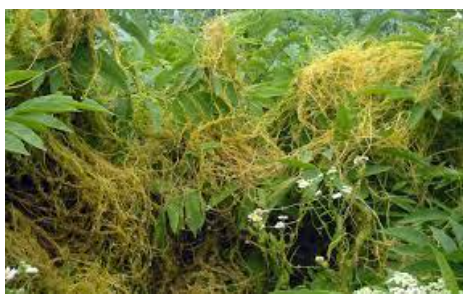
About Cuscuta Dodder
- Native Origin: Cuscuta Dodder is native to North America.
- Parasitic Nature: It is a parasitic vine that lacks roots, and it has already invaded extensive areas of trees within reserve forests, spreading within India's oldest bird sanctuary.
- Habitat and Preference: The plant is observed on Barringtonia trees, preferred by migratory water birds for nesting, where it forms a canopy and deploys numerous tendrils, creating a dense spectacle before strangling and ultimately killing the host.
- Impact on Agriculture: Cuscuta poses a significant agricultural problem in India, affecting oilseeds, pulses, and fodder crops in states such as Andhra Pradesh, Chhattisgarh, Gujarat, Orissa, West Bengal, and parts of Madhya Pradesh under both rain-fed and irrigated conditions.
- Global Recognition: Internationally, the dodder is recognized as a 'declared noxious weed' in legislation across 25 countries, with restrictions on the entry of its seeds and plant material. In the United States, it is the only weed seed whose movement is prohibited in every state.
- Longevity of Seeds: Cuscuta seeds are spheroid and possess a hard coat, enabling them to endure up to 50 years in dry storage and at least 10 years in the field.
- Germination Process: Unlike root parasites, Cuscuta seeds do not require a specific stimulant for germination, contributing to their ability to thrive and spread.
Source: IE
National Generic Document Registration System
In News: The Secretary of the Department of Land Resources introduced the National Generic Document Registration System (NDGRS) in Assam, along with the Unique Land Parcel Identification Number (ULPIN) and geo-referenced Cadastral Maps.
About National Generic Document Registration System
- Initiated by the Department of Land Resources, Ministry of Rural Development, Government of India.
- Part of the One Nation One Software initiative for registration departments nationwide.
- Developed by the National Informatics Centre Pune.
Features
- Common, Generic, and Configurable Application
- Designed for registration departments across the country.
- Configurable for state-specific instances.
- User-Friendly Interface
- Intended for sub-registrars, citizens, and apex users in registration departments.
- Online Land Buying
- Enables citizens to complete land buying processes online.
- Provides information on circle rates, property valuation, and land types.
- Transaction Restrictions
- Restricts transactions involving prohibited properties (e.g., government land, tribal land, mortgaged land).
- Online Document Submission
- Allows citizens to apply online for document submission.
- Facilitates instant payments and prior appointment scheduling.
- Reduced Office Visits
- Minimizes the need for property buyers to visit the sub-registrar's office, requiring only one visit for final signing and registration.
Source: PIB
Conservation of Migratory Species of Wild Animals (COP14)
In News: The Government of Uzbekistan will host the Fourteenth Meeting of the Conference of the Parties to the Convention on the Conservation of Migratory Species of Wild Animals (COP14) in Samarkand from February 12 to 17, 2024.
About Conservation of Migratory Species of Wild Animals (COP14)
- The Convention on the Conservation of Migratory Species, also known as the Bonn Convention, is an environmental treaty under the United Nations Environment Programme.
- Signed on June 23, 1979, in Bonn, Germany, it serves as a global platform for the conservation and sustainable use of migratory animals and their habitats.
- This convention is the sole global and UN-based intergovernmental organization dedicated exclusively to the conservation and management of terrestrial, aquatic, and avian migratory species throughout their range.
- Parties to the convention recognize the significance of conserving migratory species, especially those with an unfavorable conservation status, and emphasize the need for special attention to such species.
- Activities by CMS Parties vary from legally binding treaties, termed Agreements, to less formal instruments like Memoranda of Understanding.
- The Conference of Parties (COP) serves as the decision-making body of the convention.
- The convention comprises two Appendices, with Appendix I listing endangered migratory species, including prohibitions on their take.
- Appendix II lists species with an unfavorable conservation status and encourages range states to develop range-wide agreements for the conservation and management of these species.
Source: CMS
The Swachhata Green Leaf Rating system
In News: The Swachhata Green Leaf Rating system for the hospitality sector is currently inactive, with no participation from any State despite three communications sent by the Union Tourism Ministry.
Swachhata Green Leaf Rating Overview
- The Swachhata Green Leaf Rating is a government-initiated rating system focusing on hygiene and sanitation in the hospitality sector.
- The primary aim is to maintain world-class cleanliness standards in hotels, resorts, homestays, and similar establishments.
- Objective
- The main objective is to prevent water pollution and promote environmental cleanliness.
- Target Groups
- Hotels, lodges, homestays, 'Dharamshalas,' and camps equipped with portable toilets are the designated target groups.
- The rating is determined based on compliance with safe sanitation practices outlined in the provided guidelines.
- Launch and Collaboration
- The ranking scheme was launched in November 2023 through collaboration between the Union Tourism Ministry and the Department of Drinking Water and Sanitation.
- Implementation Structure
- A three-tiered committee system has been proposed for effective implementation:
- Verification Sub-Committee: Formed by the Sub-Divisional Magistrate (SDM) for on-ground verification.
- District Committee: Chaired by the District Collector for overseeing the district-level aspects.
- State-level Committee: Headed by the Chief Secretary of the State, responsible for the overall implementation and coordination.
Source: TH
Olive Ridley Turtles - Edukemy Current Affairs
In News: The Andhra Pradesh government has implemented a one-month fishing prohibition within a 5-km radius of Hope Island to safeguard Olive Ridley turtles from fatalities along the Kakinada coast.
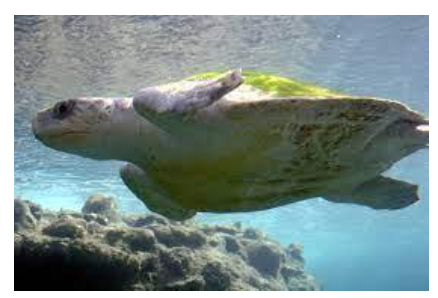
About Olive Ridley Turtles
- Olive Ridley Turtles are the smallest and most abundant sea turtles globally, known for their distinctive olive green carapace.
- Scientifically named Lepidochelys olivacea, they are recognized for their unique mass nesting event called Arribada, where thousands of females gather on the same beach to lay eggs.
- Their primary habitat includes the warm waters of the Pacific, Atlantic, and Indian oceans, with Odisha’s Gahirmatha Marine Sanctuary being the largest rookery for these sea turtles.
- Adult Olive Ridley Turtles typically measure between 62 and 70 cm in length, weighing around 35-45 kg. They exhibit one to two visible claws on each of their paddle-like flippers.
- Omnivorous in nature, they consume both plants and animals, and their solitary behavior makes them prefer the open ocean.
- These turtles lead oceanic lives, undertaking extensive migrations of thousands of kilometers between feeding and mating grounds throughout the year.
- Conservation status: Vulnerable on the IUCN Red List, Schedule 1 under the Wildlife Protection Act, 1972, and listed on Appendix I of CITES.
Source: TH
Bubonic Plague
In News: Authorities in Oregon, USA, have reported a rare human case of bubonic plague, likely transmitted by a pet cat.
About Bubonic Plague
- Bubonic Plague is an infectious disease caused by the bacterium Yersinia pestis, typically found in small mammals and their fleas.
- Y. pestis is capable of affecting both humans and animals, primarily transmitted by fleas.
- The disease is named after the swollen lymph nodes (buboes) it induces in infected individuals.
- Historically known as the Black Death, it caused millions of deaths in Europe during the Middle Ages.
- Other forms of plague include Septicemic plague, which spreads throughout the body, and Pneumonic plague, affecting the lungs.
- The case-fatality ratio for bubonic plague is 30% to 60%, and pneumonic plague is always fatal when untreated.
- Symptoms of bubonic plague include sudden high fever, chills, abdominal, arm, and leg pains, headaches, and swollen lymph nodes (buboes).
- Y. pestis is mainly spread by fleas on rodents and animals, with transmission occurring through flea bites, direct contact with infected tissues, and inhalation of respiratory droplets.
- The incubation period for bubonic plague is typically 2 to 8 days.
- Bubonic plague is treatable and curable with antibiotics, including Ciprofloxacin, levofloxacin, moxifloxacin, Gentamicin, and Doxycycline.
- Untreated cases can be fatal.
Source: NDTV
UPI Services in Sri Lanka and Mauritius
In News: In a collaborative effort, the Prime Minister of India, along with Sri Lanka's President, Mr. Ranil Wickremesinghe, and Mauritius' Prime Minister, Mr. Pravind Jugnauth, jointly inaugurated the introduction of Unified Payment Interface (UPI) services in Sri Lanka and Mauritius.

Understanding RuPay and UPI
- RuPay Overview
- Developed by the National Payments Corporation of India (NPCI), RuPay is a domestic card payment network.
- It encompasses various card variants, including government scheme cards, catering to diverse segments of society.
- RuPay's expansion beyond Asia includes countries like Nepal, Bhutan, Singapore, UAE, and now Mauritius, facilitating secure electronic payments.
- RuPay's Presence in Mauritius
- Mauritius becomes the first non-Asian country to issue RuPay cards.
- The deployment of RuPay technology enables local issuance through the Mauritius Central Automated Switch (MauCAS) card network.
- MauCAS, operated by the Bank of Mauritius, serves as a digital hub for routing payments among operators.
- UPI (Unified Payments Interface) Introduction
- Launched in 2016 by NPCI, UPI is a real-time payment system built on the IMPS infrastructure.
- It allows instant fund transfers between any two parties' bank accounts and integrates various banking features into a single mobile application.
- Uptake of UPI
- UPI witnessed over 100 billion transactions in 2023, totaling Rs 2 lakh crores, demonstrating its widespread adoption.
- The acceptance of UPI payments extends beyond India, including countries like France, UAE, Mauritius, Sri Lanka, Singapore, Bhutan, and Nepal.
Benefits for Users in Mauritius and Sri Lanka
- Seamless Transactions
- Adoption of RuPay and UPI facilitates convenient and seamless transactions for users within and between India, Mauritius, and Sri Lanka.
- Cross-border transactions become more accessible, eliminating the need for currency exchange and simplifying financial interactions.
- Enhanced Financial Access
- RuPay cards' acceptance at ATMs and PoS terminals in Mauritius expands digital payment accessibility.
- UPI connectivity in Sri Lanka enables QR code-based payments, offering a convenient alternative to traditional methods.
- Promotion of Financial Inclusion
- The availability of RuPay cards and UPI services promotes financial inclusion by catering to individuals from diverse socio-economic backgrounds.
- UPI transactions present a cost-effective solution, reducing expenses associated with traditional banking services.
- Strengthened Economic Ties
- Seamless payment solutions contribute to trade and tourism growth between India, Mauritius, and Sri Lanka.
- Increased digital transactions support local businesses, enhance transparency, and reduce reliance on cash-based transactions.
- Innovation and Technological Advancement
- Introduction of RuPay and UPI reflects a commitment to digital innovation, positioning Mauritius and Sri Lanka as progressive economies.
- Users benefit from advanced payment technologies, gaining access to innovative financial solutions for efficient and secure financial management.
|
UPSC Previous Year Questions Prelims (2018) Q. With reference to digital payments, consider the following statements:
Which of the statements given above is/are correct? (a) 1 only Ans: (a) Prelims (2017) Q2. Which of the following is a most likely consequence of implementing the ‘Unified Payments Interface (UPI)’? (a) Mobile wallets will not be necessary for online payments. Ans: (a) Prelims (2017) Q3. Consider the following statements:
Which of the statements given above is/are correct? (a) 1 only Ans: (c) Mains (2019) Q. Implementation of Information and Communication Technology (ICT) based Projects/ Programmes usually suffers in terms of certain vital factors. Identify these factors, and suggest measures for their effective implementation. |
Source: TH
MSP Legislation Sparks Farmers' Return to Protests
In News: The article explores the demand of protesting farmers in India for a legal guarantee of the Minimum Support Price (MSP).
Understanding Minimum Support Price (MSP) in India
- Definition of MSP
- The MSP is a government-assured price for agricultural produce, serving as a safety net against sharp market price declines.
- Crops Covered Under MSP
- The government designates MSPs for 22 crops, including cereals, pulses, oilseeds, and others, with a focus on stabilizing prices for wheat and paddy through procurement.
- Calculation of MSP
- MSP determination relies on recommendations from the Commission for Agricultural Costs & Prices (CACP), utilizing three main formulas, including A2, A2+FL, and C2, to ensure fair compensation for farmers.
Rationale Behind Legalizing MSP
- Ensuring Financial Viability
- Legalizing MSP guarantees farmers a minimum price, securing their income and protecting against market uncertainties, ultimately promoting financial viability in agriculture.
- Debt Reduction for Farmers
- Legal MSP aims to alleviate the increasing debt burden on farmers, providing a safety net against financial challenges and ensuring fair returns on their investments.
- Supporting Livelihoods
- By legalizing MSP, the government can support the livelihoods of millions of farmers, particularly those vulnerable to market fluctuations, contributing to poverty alleviation and rural development.
- Risk Mitigation
- Legalizing MSP acts as a safety net, mitigating the risk of income loss for farmers during unfavorable market conditions, including natural disasters and market forces.
- Addressing Market Imperfections
- MSP legalization can regulate middlemen and address disparities, ensuring farmers receive a fair price directly, contributing to a more equitable agricultural system.
- Promoting Agricultural Growth
- Legalizing MSP encourages farmers to invest in sustainable agricultural practices, providing price stability and income security, thereby promoting overall agricultural growth.
Challenges in Legalizing MSP
- Financial Burden
- The procurement of crops at MSP poses a financial challenge, requiring substantial resources, and balancing budgetary allocations with other essential expenditures is a concern.
- Disincentive for Investment
- Legal MSP may discourage private investment in agriculture, limiting innovation and modernization efforts, and hindering the sector's overall growth.
- Water Scarcity Concerns
- MSP-supported crops, such as paddy and sugarcane, are water-intensive, raising concerns about exacerbating water scarcity issues in regions where these crops are extensively cultivated.
- Impact on Non-MSP Crops
- Legalizing MSP may lead to the neglect of non-MSP crops, impacting food security, dietary diversity, and nutritional outcomes, particularly among vulnerable populations.
- Reduced Export Competitiveness
- Higher MSPs may make MSP-supported crops less competitive internationally, potentially leading to trade disputes and affecting export volumes.
The Way Forward for MSP Implementation
- Balanced Agricultural Pricing Policy
- The government must develop a balanced transition to agricultural pricing policies, combining mechanisms like MSP and direct income support schemes for remunerative prices.
- Implement Swaminathan Committee Recommendations
- Enforcing the Swaminathan Committee's recommendation of setting MSP at least 50% higher than the weighted average cost of production (C2) is crucial for fair compensation.
- Expansion of MSP Criteria
- Include factors like average expenditure on education and health services when determining MSP to provide a more comprehensive understanding of farmers' costs.
- Introduction of Price Deficiency Payments (PDP)
- Consider implementing Price Deficiency Payments, where the government pays farmers the difference between market prices and MSP, without physically procuring the crops.
- Enhancing Farmers' Income
- Incorporate agriculture activities into schemes like Mahatma Gandhi National Rural Employment Guarantee Scheme (MGNREGS) and increase daily wages to improve farmers' income.
- Investing in Agricultural Infrastructure
- Increase public investment in rural infrastructure, technology adoption, and access to credit, fostering agricultural productivity and market access.
- Improving Land and Water Management
- Implement sustainable land and water management practices to conserve resources, prevent degradation, and enhance agricultural resilience to climate change.
- Empowering Farmers
- Strengthen farmers' organizations, cooperatives, and producer groups to enable collective bargaining, market access, and participation in decision-making processes.
- Ensuring Social Protection
- Expand social safety nets and insurance schemes to provide income support during periods of distress, ensuring the well-being of vulnerable farming households.
- Improving Governance
- Enhance governance and regulatory frameworks to minimize bureaucratic hurdles, corruption, and market distortions, promoting agricultural development and farmer welfare.
Conclusion
Prioritizing the needs of Indian farmers is crucial for ensuring food security, economic growth, and social equity. By implementing comprehensive policies and supporting agricultural initiatives, India can build a resilient and prosperous future for its citizens.
|
UPSC Previous Year Questions Prelims (2020) Q. Consider the following statements:
Which of the statements given above is/are correct? (a) 1 only Ans: D Mains (2019) Q. What do you mean by Minimum Support Price (MSP)? How will MSP rescue the farmers from the low income trap? |
Source: IE
MISSION API – 10: REDUCTION OF MALARIA- Case Study of the Day
"In the Aspirational District of Koraput, facing high Malaria-related deaths, Mission API–10 was initiated on July 15, 2017.
- Focused on the hilly terrain and forest cover, it incorporates Long Lasting Insecticidal Nets (LLINs) and supply-side interventions.
- 'Bell ringing,' night patrolling, and bottom-up incentives enhance LLIN use.
- Recognized with an 'Award of Appreciation,' the health team's efforts reduced the Annual Parasite Incidence (API) to 2 through extensive awareness campaigns, market demonstrations, posters, Nidhi Ratha, and rallies."

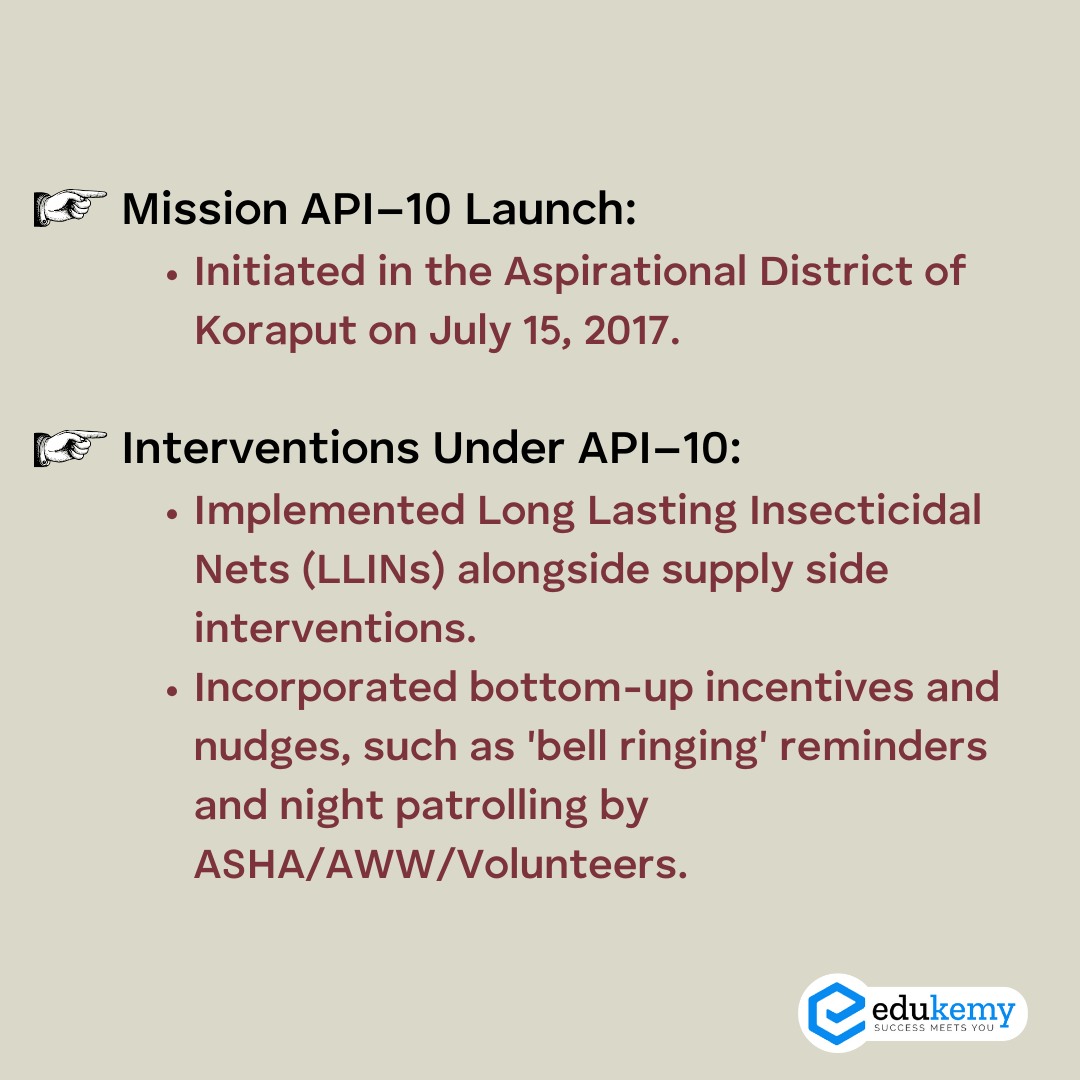
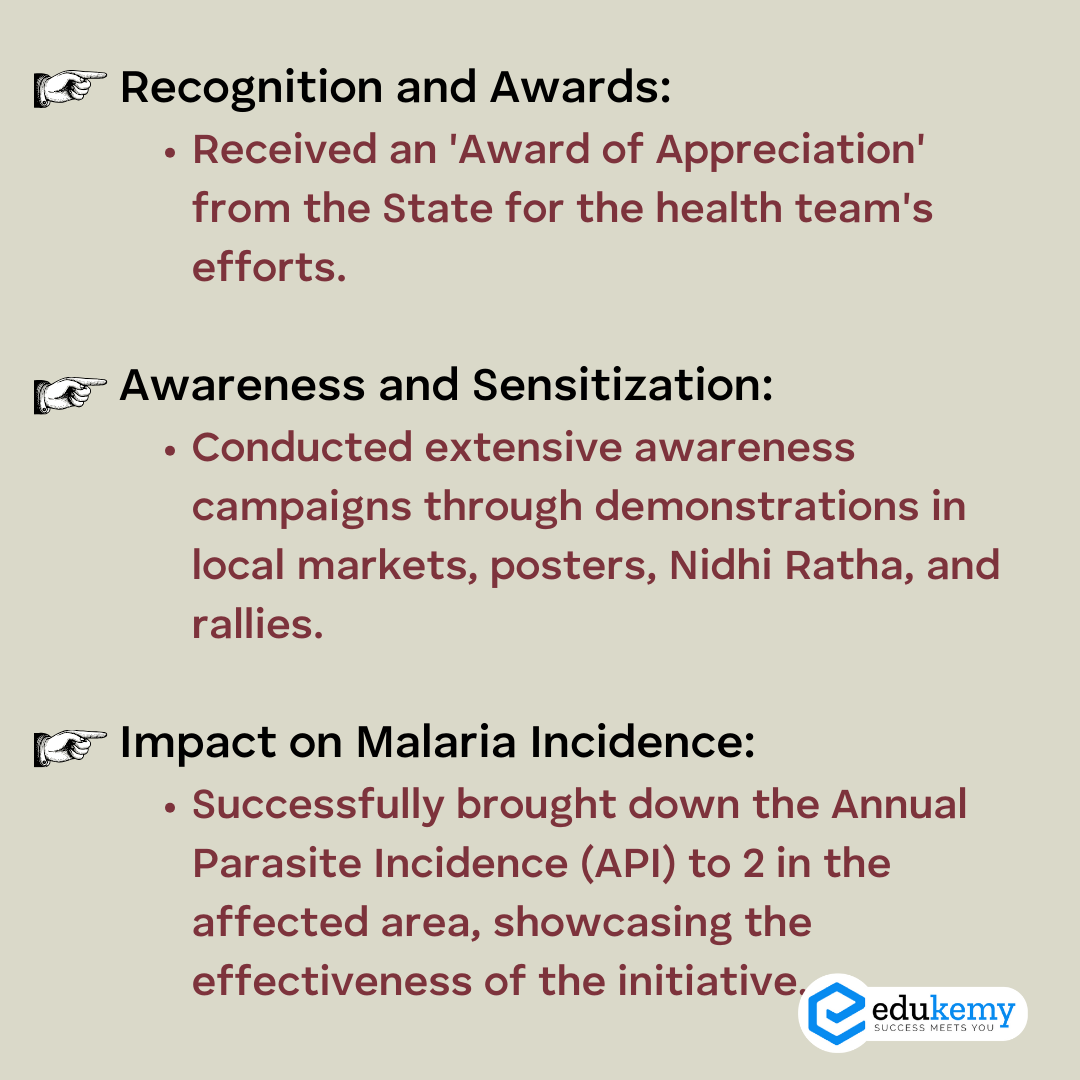
Share the article
Edukemy’s Current Affairs Quiz is published with multiple choice questions for UPSC exams
MCQ
Get Latest Updates on Offers, Event dates, and free Mentorship sessions.

Get in touch with our Expert Academic Counsellors 👋
FAQs
UPSC Daily Current Affairs focuses on learning current events on a daily basis. An aspirant needs to study regular and updated information about current events, news, and relevant topics that are important for UPSC aspirants. It covers national and international affairs, government policies, socio-economic issues, science and technology advancements, and more.
UPSC Daily Current Affairs provides aspirants with a concise and comprehensive overview of the latest happenings and developments across various fields. It helps aspirants stay updated with current affairs and provides them with valuable insights and analysis, which are essential for answering questions in the UPSC examinations. It enhances their knowledge, analytical skills, and ability to connect current affairs with the UPSC syllabus.
UPSC Daily Current Affairs covers a wide range of topics, including politics, economics, science and technology, environment, social issues, governance, international relations, and more. It offers news summaries, in-depth analyses, editorials, opinion pieces, and relevant study materials. It also provides practice questions and quizzes to help aspirants test their understanding of current affairs.
Edukemy's UPSC Daily Current Affairs can be accessed through:
- UPSC Daily Current Affairs can be accessed through Current Affairs tab at the top of the Main Page of Edukemy.
- Edukemy Mobile app: The Daily Current Affairs can also be access through Edukemy Mobile App.
- Social media: Follow Edukemy’s official social media accounts or pages that provide UPSC Daily Current Affairs updates, including Facebook, Twitter, or Telegram channels.



